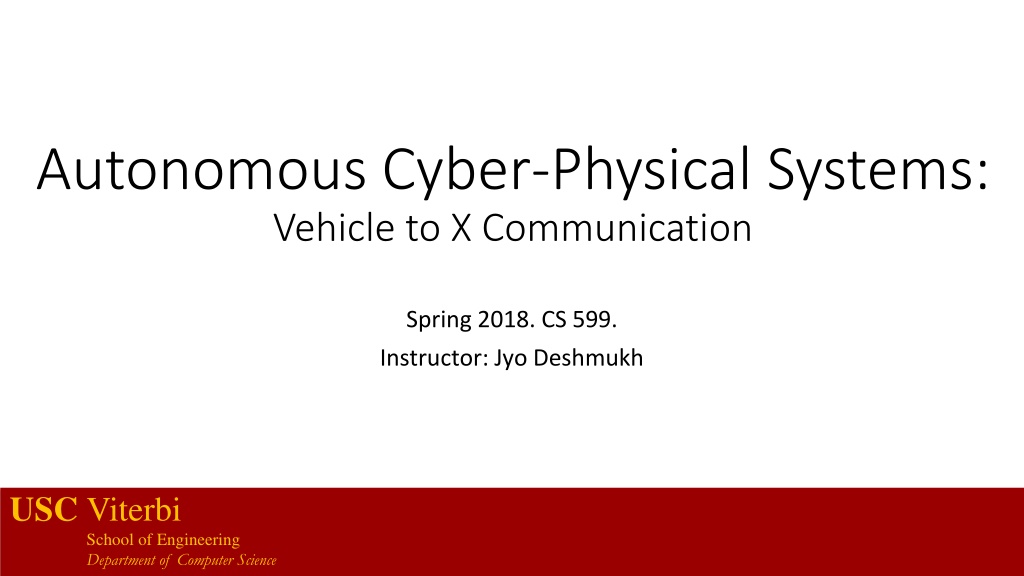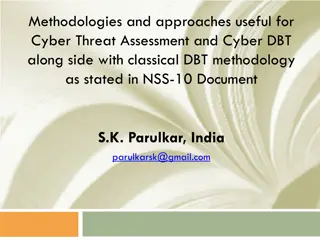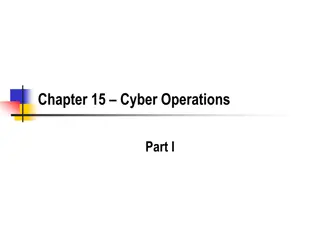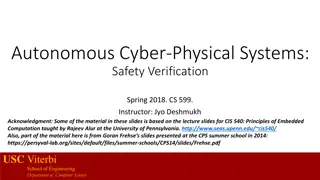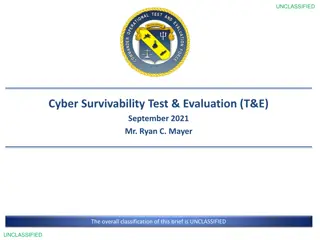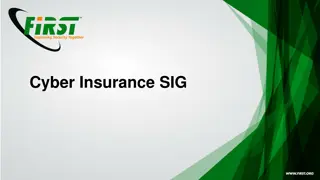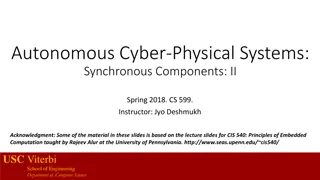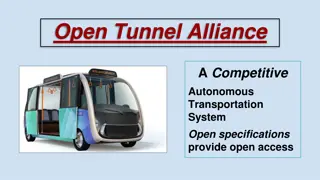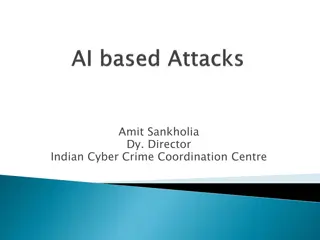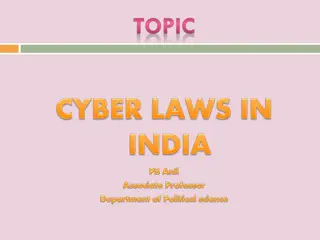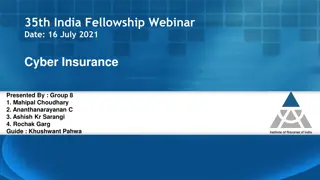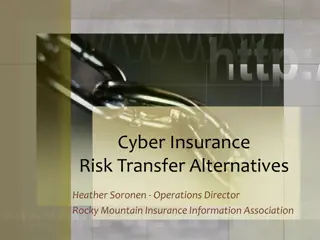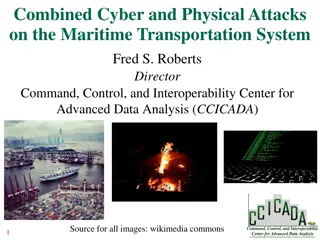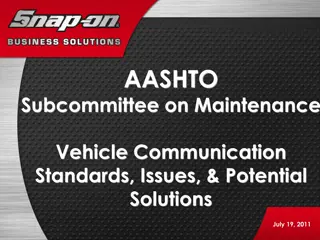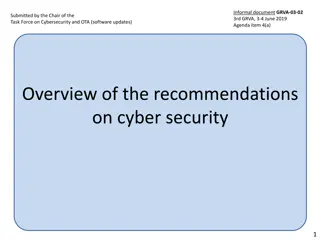Comprehensive Overview of Autonomous Cyber-Physical Systems in Vehicle Communication
Exploring Autonomous Cyber-Physical Systems with a focus on Vehicle-to-X Communication in CS 599 course at USC Viterbi School of Engineering. Topics include V2V and V2I communication, wireless technologies, Co-operative Adaptive Cruise Control, V2X applications, and more.
Download Presentation

Please find below an Image/Link to download the presentation.
The content on the website is provided AS IS for your information and personal use only. It may not be sold, licensed, or shared on other websites without obtaining consent from the author. Download presentation by click this link. If you encounter any issues during the download, it is possible that the publisher has removed the file from their server.
E N D
Presentation Transcript
Autonomous Cyber-Physical Systems: Vehicle to X Communication Spring 2018. CS 599. Instructor: Jyo Deshmukh USC Viterbi School of Engineering Department of Computer Science
Layout Basic capabilities of V2V and V2I Co-operative Adaptive Cruise Control Autonomous Intersection Management Collaborative Merging Class Wrap-up and Big-picture story USC Viterbi School of Engineering Department of Computer Science 2
Wireless technologies and their use USC Viterbi School of Engineering Department of Computer Science 3
V2V communication Single hop: Vehicle communicates directly with another vehicle Multi-hop: Vehicle uses intermediate nodes for communication V2V has been used for safety: Stopped vehicle or obstacle avoidance on highways Merging assistance from a slow incoming lane to a crowded road Intersection safety and collision warning systems Consensus around DSRC (Dedicated Short-Range Communication) using IEEE 802.11p/WAVE standards Potential applications: multi-vehicle sensor fusion for localization, mapping Platooning and energy management USC Viterbi School of Engineering Department of Computer Science 4
V2I communication Vehicle to Infrastructure communication Applications: Electronic Toll Collection Intersection safety with Smart traffic lights (Cooperative Intersection Collision Avoidance System) Better route-planning with a traffic-congestion aware cloud system Computing on the cloud for complex optimization situations USC Viterbi School of Engineering Department of Computer Science 5
Cooperative Adaptive Cruise Control (CACC) Used for platoons of vehicles (e.g. trucks) Several goals: Improve safety Improve traffic flow dynamics by damping disturbances (new cars, braking, bumps in the road) Increasing highway capacity by shorter following gaps Saving energy and pollution through aerodynamic drafting Improving driver comfort and convenience USC Viterbi School of Engineering Department of Computer Science 6
CACC with V2X Many V2V variants based on where information comes from Immediate leader or/and follower or/and the overall Platoon Leader or/and any vehicle in range Simplest scheme: Pairwise sharing between vehicle and immediate leader V2I schemes: communicate with traffic management center/roadside devices either statically or dynamically Can help with intersections Can help with green-driving or eco-driving USC Viterbi School of Engineering Department of Computer Science 7
CACC uses different gap regulation strategies Constant clearance or constant distance gap (CDG) Separation does not change with vehicle velocity Gives experience of mechanical linkage between vehicles Requires more formal platoon architecture and tight communication between platoon leader and followers Communication interruption can cause safety hazards Need larger gaps to ensure safety of platoon (Emergency brake by leader can cause domino effect) USC Viterbi School of Engineering Department of Computer Science 8
Constant Time Gap Resembles how normal human drivers drive (except on 110 in LA ) Distance between vehicles is proportional to their speed + a small fixed offset distance E.g. doubling of speed causes doubling of gap between vehicles Time gap criterion described in terms of time between rear bumper of leading vehicle and front bumper of trailing vehicle pass a fixed point on te roadway Often described as headway or time headway Vehicles in CTG CACC are often called a string of vehicles rather than platoon USC Viterbi School of Engineering Department of Computer Science 9
Constant Safety-Factor Criterion Motivated by guaranteeing that even most severe incidents would involve only one platoon With small constant-clearance-separations, severe incidents require hard braking Hardest braking would be by the last vehicle, Most dangerous condition is when lead vehicle has limited braking ability Sets minimum distance between platoons such that two platoons do not collide based on above factors Produces inter-platoon separation proportion to square of cruising speed USC Viterbi School of Engineering Department of Computer Science 10
CACC String formation in trucks One or more truck drivers activate CACC and set desired speed and gap May set preference for leader or follower when forming a new string CACC local coordination feature searches for additional trucks or existing strings to couple with Joining driver is displayed list of nearby trucks or strings (graphically or textually) Once joining driver selects a platoon to couple with, local coordination will confirm with platoon leader and instruct leader to slow down and joining truck to speed up Lead driver and joining driver are shown a target speed and lane in which to travel Once joining truck is behind the leader or string, CACC s vehicle-following mode will engage, and lead truck s speed will be restored and relayed USC Viterbi School of Engineering Department of Computer Science 11
CACC steady-state cruising Steady-state cruising is what hopefully happens most of the time Drivers still have to actively steer (unless they have lane-tracking-control) and monitor traffic Steady-state cruising interrupted when trucks join or split strings, or when a non-platoon vehicle intervenes Cut-ins can be handled by dynamically splitting the string and commanding a new leader and dynamically merging strings when the disturbing vehicle goes away USC Viterbi School of Engineering Department of Computer Science 12
CACC string splits and faults CACC needs to handle trucks leaving string Ideally, departing truck signals intent and remaining string close gaps to maintain platoon structure In some cases may require string to be split while the truck in the middle departs As you can see, the above protocols have NUMEROUS fault conditions, errors and abnormal operating conditions (obstacle in the road, accidents, etc.) Safety: model each truck as an asynchronous process and reason about composition of asynchronous processes! Specifications: Safety and String stability USC Viterbi School of Engineering Department of Computer Science 13
String stability Suppose each vehicle looks only at vehicle in front, and for any pair of vehicles, the one with smaller index is the leader We define two errors: ??= ?? 1 ?? ?? ???= ?? 1 ?? Here, ?? is the range error, or the error from trying to maintain desired range ??, and ??? is the range rate error Assuming constant time-headway, i.e. ??= ???, where ? is the constant time head-way for the ?? vehicle, range error can be written as: ??= ?? 1 ?? ??? USC Viterbi School of Engineering Department of Computer Science 14
String stability definition For a uniform vehicle string, ?: ?= A uniform vehicle string is string stable if ??+1 2 ?? 2 Assume each car s following algorithm is represented by a linear system, then this translates to the overall system having the L-infinity gain being less than 1 If you create a new platooning algorithm, string stability may be an important property to prove USC Viterbi School of Engineering Department of Computer Science 15
Autonomous Intersection Management AIM protocol and its variants proposed based on V2I communication Main idea : Each car equipped with a driver agent Each intersection equipped with an intersection manager Driver agents call ahead to reserve space-time in an intersection Intersection manager decides to grant or reject reservation requests according to an intersection control policy USC Viterbi School of Engineering Department of Computer Science 16
AIM protocol4 Approach vehicle announces arrival to manager Vehicle indicates its size, predicted arrival time, velocity, acceleration, arrival and departure lanes Intersection manager simulates vehicle s path through the intersection, checking for conflicts with paths of previously processed vehicles If there are no conflicts, issues a reservation It is the vehicle s responsibility to arrive at and travel through the reserved space- time block within some range of error tolerance In case of conflict, intersection manager suggests an alternate later reservation Car enters intersection only if reservation successful Upon leaving intersection, car conveys successful passage to the manager 1. 2. 3. 4. 5. 6. 7. 8. USC Viterbi School of Engineering Department of Computer Science 17
Intersection control policies Divide intersection into grid of reservation tiles USC Viterbi School of Engineering Department of Computer Science 18
Many AIM5 variants with different concerns Decentralized (vehicles coordinating among themselves) vs. Centralized (manager) Deliberative (planning entire trajectories) vs. reactive (planning trajectories in real-time) Robust (Safety margins) vs. efficient (more throughput at the intersection) Cooperative (optimizing overall traffic flow) vs. Egoistic (optimizing your own speed/time) Homogenous (all vehicles treated the same) vs. Heterogeneous Modeling AIM: asynchronous, timed, & hybrid process models used! USC Viterbi School of Engineering Department of Computer Science 19
Collaborative merge Purpose: allow vehicles merging onto a freeway from a ramp to do so in safe fashion Can be formulated as a specific case in autonomous intersection management Specialized approaches based on highway ramp metering have existed for some time (these do not utilize V2V capability, and do not guarantee safety) USC Viterbi School of Engineering Department of Computer Science 20
Collaborative merge Region at center of intersection called merging zone with length ? Control zone of length ? where vehicles can communicate Each vehicle modeled with simple second-order dynamics (position, velocity, acceleration) Centralized solution based on layered control approaches USC Viterbi School of Engineering Department of Computer Science 21
Two-layered control approach for merging Centralized approach (V2I only) First layer Assumes each vehicle is traveling at constant speed Computes time for each vehicle to merge into the control zone based on this assumption Second layer Determines conflicts in merging sequence Computes required acceleration value based on heuristic rules Generalization with different layers of control has been proposed Optimization: minimizing vehicle overlap (crash!) and travel time USC Viterbi School of Engineering Department of Computer Science 22
Decentralized approach Virtual vehicle mapped onto the freeway before actual merging occurs Allows vehicles to perform smoother and safer control actions Uses slot-based traffic management (vehicles drive into a virtual slot) Vehicles use V2V and V2I communication with vehicles in range Other approaches based on MPC also exist USC Viterbi School of Engineering Department of Computer Science 23
Design challenges Course Concepts Modeling protocols, decision layer components Synchronous and Asynchronous processes Understanding system-level safety using synchronous and asynchronous composition Verification using Model Checking, Inductive Invariants Liveness properties with LTL, CTL Model-based and Scenario-based Testing approaches USC Viterbi School of Engineering Department of Computer Science 24
Design challenges Course Concepts Modeling Controllers, Path planning Timed and Hybrid Processes, Dynamical Systems Markov Decision Processes & Markov Chains Verification using Model Checking, Inductive invariants, safety certificates (barrier certificates), Liveness checking with LTL, CTL, STL Testing using Falsification-based approaches Software synthesis using Temporal Logic-based approaches, reinforcement learning USC Viterbi School of Engineering Department of Computer Science 25
Design Challenges Course Concepts Reasoning about environments, physical processes to be controlled Dynamical systems models, hybrid processes Signal Temporal Logic as a way to express Cyber-Physical systems specifications Testing and Falsification approaches Reasoning about safety and security Models for perception USC Viterbi School of Engineering Department of Computer Science 26
How does everything fit together? You want to develop a new CPS/IoT system with autonomy Analyze its environment: model it as a dynamical system or a stochastic system (e.g. PoMDPs) Analyze the different components required in the software stack Perception vs. Decision/Planning vs. Control Analyze what models to use for the control algorithms Choices are: Traditional control schemes (PID/MPC), state-machines (synchronous vs. asynchronous based on communication type), AI/planning algorithms, hybrid control algorithms, or combinations of these USC Viterbi School of Engineering Department of Computer Science 27
Safety is the key!! Try to specify the closed-loop system as something you can simulate and see its behaviors Integrative modeling environment such as Simulink (plant models + software models) Specify requirements of how you expect the system to behave (STL, LTL, or your favorite spec. formalism) This step is a DO NOT MISS. It will provide documentation of your intent, and also a machine-checkable artifact Test the system a lot, and then test some more Apply formal reasoning wherever you can. Proofs are great if you can get them Safety doesn t end at modeling stage; continue reasoning about safety after deployment (through monitoring etc.) USC Viterbi School of Engineering Department of Computer Science 28
Its been a fun class Models of computation Asynchronous, Synchronous, Timed, Hybrid Processes, Dynamical Systems, Probabilistic Models, Simulink Safe Autonomous CPS MODELING Basics of Safety-Aware Mindset Basics of Control PID, MPC, Nonlinear control, Observer design (Kalman filter) Specification Languages (LTL, CTL, STL) Basics of Perception Vision-based systems, CNNs Falsification and Testing Safety Invariants + Proofs AUTONOMY Basics of Planning Path planning, Reinforcement learning Reachability, Model Checking SAFETY Basics of Security and Communicating Autonomous CPS USC Viterbi School of Engineering Department of Computer Science 29
References [1] Shladover, Steven E., et al. "Cooperative adaptive cruise control: Definitions and operating concepts." Transportation Research Record: Journal of the Transportation Research Board 2489 (2015): 145-152. [2] ibid., https://escholarship.org/uc/item/7jf9n5wm [3] Liang, Chi-Ying, and Huei Peng. "String stability analysis of adaptive cruise controlled vehicles." JSME International Journal Series C Mechanical Systems, Machine Elements and Manufacturing 43.3 (2000): 671-677. [4] Stone, Peter, Shun Zhang, and Tsz-Chiu Au. "Autonomous intersection management for semi-autonomous vehicles." Routledge Handbook of Transportation. Routledge, 2015. 116-132. [5] Qian, Xiangjun, et al. "Autonomous Intersection Management systems: criteria, implementation and evaluation." IET Intelligent Transport Systems 11.3 (2017): 182-189. [6] de Campos, Gabriel Rodrigues, et al. "Traffic coordination at road intersections: Autonomous decision-making algorithms using model-based heuristics." IEEE Intelligent Transportation Systems Magazine 9.1 (2017): 8-21. [7] Rios-Torres, Jackeline, and Andreas A. Malikopoulos. "A survey on the coordination of connected and automated vehicles at intersections and merging at highway on-ramps." IEEE Transactions on Intelligent Transportation Systems 18.5 (2017): 1066-1077. USC Viterbi School of Engineering Department of Computer Science 30
